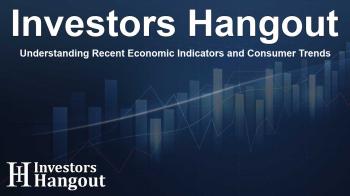Understanding Recent Economic Indicators and Consumer Trends

Recent Economic Indicators Highlight Consumer Resilience
The economic landscape continues to be shaped by various indicators, particularly the Personal Consumption Expenditures (PCE), which excludes food and energy costs. This Core PCE index has seen a steady increase of 0.2%, contributing to a 2.8% rise over the past year. Despite its fluctuations, this metric remains firmly entrenched in the 2.7% to 2.8% range, significantly above the Federal Reserve's target of 2%.
Headline PCE: A Broader Perspective on Inflation
Looking more broadly at the PCE, the data reveals a 0.3% increase in December and a total increase of 2.6% over the past year. A notable point is the accelerating growth in PCE inflation, attributed largely to rising energy costs, a trend that has persisted for three consecutive months.
Growth in Personal Income Shows Positive Momentum
In terms of individual financial health, personal income rose by 0.4% in December, accumulating a total increase of 5.3% over the year. When inflation is accounted for, personal incomes have also experienced a rise for the eighth consecutive month, showing an encouraging 2.7% increase year-on-year. This growth indicates that consumers are gradually adjusting to the previous inflation surge, albeit the recovery process may take some time.
Consumer Spending Trends: A Closer Look
Consumer spending, a crucial driver of economic activity, witnessed a significant rise of 0.7% in December, culminating in an impressive 5.7% increase over the past year. This surge in personal spending is noteworthy, marking a point where total spending has soared to approximately 38% above pre-COVID levels. Such a vibrant consumer environment bodes well for the overall economy.
Services vs. Goods: Spending Patterns
Delving deeper into spending patterns, expenditures on services grew by 0.6% in December, demonstrating a robust increase of 6.7% year-on-year. In contrast, spending on goods rose even more sharply at 0.9% in December and 3.5% across the last year. These figures provide valuable insights into changing consumer preferences and the evolving market landscape.
Inflation-Adjusted Spending: Another Positive Indicator
When adjusting for inflation, real consumer spending experienced a 0.5% increase in December and a 3.2% rise over the year, now sitting 15% above the pre-pandemic peak. This metric illustrates that, despite challenges, consumers are spending more in real terms, indicating a resilient economic backdrop.
The Federal Reserve's Interest Rate Dilemma
Current economic data aligns closely with expectations on inflation and incomes, while personal spending surpasses forecasts. Given that personal spending comprises around 70% of GDP, these indicators validate previous economic growth assessments. Despite the high inflation rate, there’s little evidence suggesting the Federal Reserve’s interest rate policies are restrictive enough to trigger a rate cut in the near future. In fact, while Federal Reserve Chairman Jerome Powell didn't hint at any imminent rate hikes, the ongoing inflation struggle points towards a prolonged period of steady rates.
Frequently Asked Questions
1. What does the Core PCE indicate about inflation?
The Core PCE measures the inflation rate while excluding volatile food and energy prices, providing a clearer view of overall inflation trends.
2. How did personal income perform recently?
Personal income rose by 0.4% in December and increased by 5.3% over the last year, indicating positive growth even amidst inflationary pressures.
3. What trends were observed in consumer spending?
Consumer spending rose by 0.7% in December, marking a total increase of 5.7% year-over-year, reflecting resilience in consumer confidence and behavior.
4. How does inflation-adjusted spending impact the economy?
Inflation-adjusted spending, which increased by 0.5% in December, shows consumers are spending more in real terms, which is a strong indicator of economic stability.
5. What are the expectations for Federal Reserve interest rates?
Current economic indicators suggest the Federal Reserve will likely maintain steady interest rates in the near term as the battle against inflation continues.
About The Author
Contact Evelyn Baker privately here. Or send an email with ATTN: Evelyn Baker as the subject to contact@investorshangout.com.
About Investors Hangout
Investors Hangout is a leading online stock forum for financial discussion and learning, offering a wide range of free tools and resources. It draws in traders of all levels, who exchange market knowledge, investigate trading tactics, and keep an eye on industry developments in real time. Featuring financial articles, stock message boards, quotes, charts, company profiles, and live news updates. Through cooperative learning and a wealth of informational resources, it helps users from novices creating their first portfolios to experts honing their techniques. Join Investors Hangout today: https://investorshangout.com/
The content of this article is based on factual, publicly available information and does not represent legal, financial, or investment advice. Investors Hangout does not offer financial advice, and the author is not a licensed financial advisor. Consult a qualified advisor before making any financial or investment decisions based on this article. This article should not be considered advice to purchase, sell, or hold any securities or other investments. If any of the material provided here is inaccurate, please contact us for corrections.

